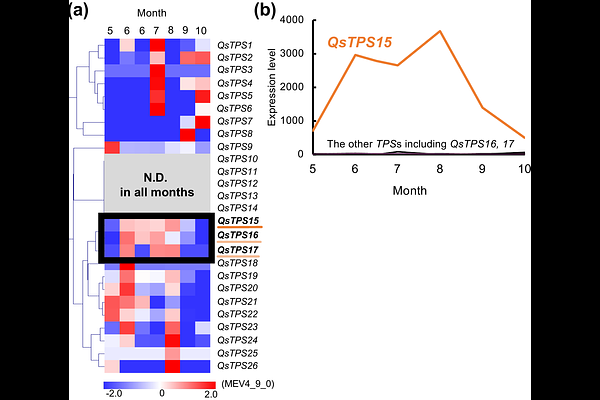Molecular basis behind the isoprene emission diversity in Fagaceae

Molecular basis behind the isoprene emission diversity in Fagaceae
Koita, S.; Munakata, R.; Fukushima, K.; Nagano, A. J.; Ikezaki, Y.; Satake, A.; Saito, T.; Miura, K.; Sugiyama, A.; Yazaki, K.
AbstractPlants emit a large amount of volatile organic compounds (VOCs) into the atmosphere, reaching approximately 109 tons of carbon per year. These biogenic VOCs exhibit significant chemical diversity, with terpenoids being the dominant group, and isoprene accounting for nearly half of the total biogenic VOCs. Due to its high chemical reactivity, isoprene has a strong impact on atmospheric quality and climate. Quercus species (Fagaceae) are known to be the main isoprene emitters in the Northern Hemisphere. However, isoprene synthase is unknown in the entire Fagaceae family. Notably, even within a single genus such as Quercus, both isoprene-emitting and non-emitting species are present, yet the molecular basis of this dichotomy remains unclear. Here, we report the identification of the IspS gene from the isoprene-emitting species Quercus serrata (QsIspS1) through seasonal transcriptome analysis and its detailed biochemical characterization. We also identified two genes with high sequence similarity to QsIspS1 in the genomes of non-emitting species: Q. glauca (QgIspS1-like) and Lethocarpus edulis (LeIspS1-like). We discovered mutations in these sequences that likely impair their function. Biochemical analysis revealed that QgIspS1-like is a monoterpene synthase, whereas LeIspS1-like is a pseudogene incapable of isoprene synthesis, explaining these plants\' inability to emit isoprene. Furthermore, site-directed mutagenesis revealed an amino acid that plays a pivotal role in the substrate and product specificities of isoprene synthase. Our findings provide new insight into the molecular mechanisms of isoprene emission diversity in Fagaceae.